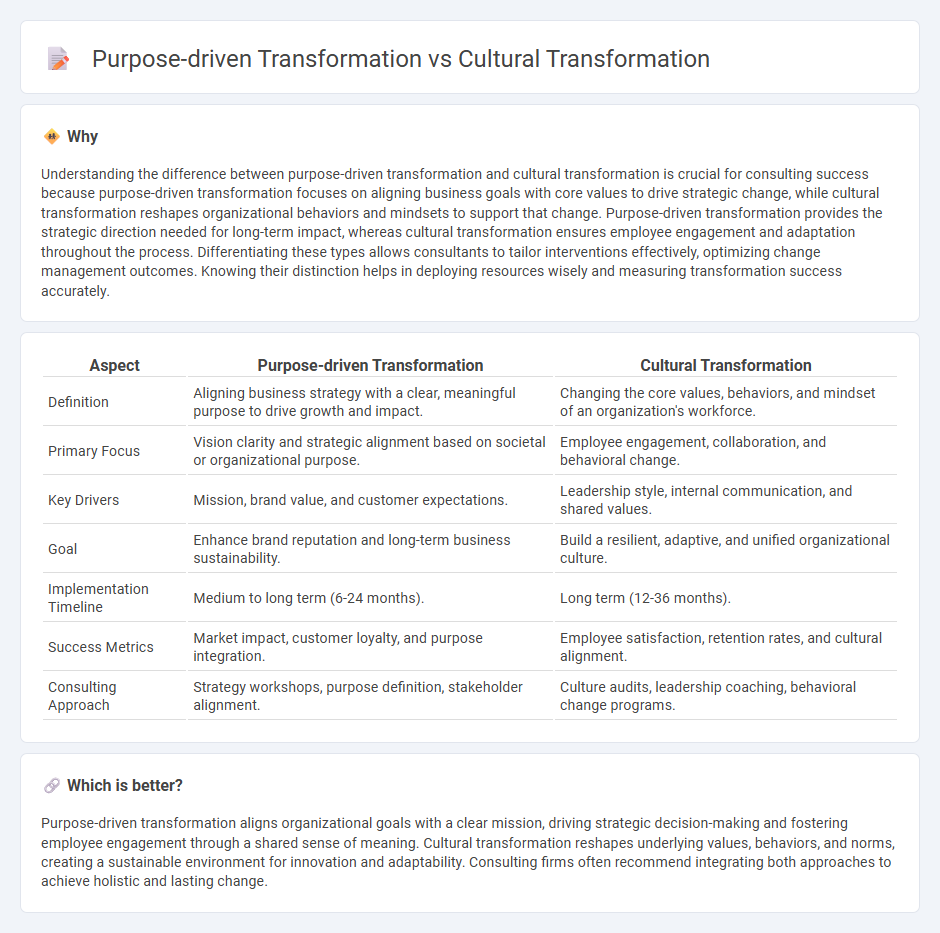
Purpose-driven transformation aligns organizational strategies with core values to boost meaningful impact and stakeholder engagement. Cultural transformation focuses on reshaping mindset, behaviors, and shared beliefs to foster innovation and resilience within teams. Explore how combining these approaches can drive sustainable success and organizational growth.
Why it is important
Understanding the difference between purpose-driven transformation and cultural transformation is crucial for consulting success because purpose-driven transformation focuses on aligning business goals with core values to drive strategic change, while cultural transformation reshapes organizational behaviors and mindsets to support that change. Purpose-driven transformation provides the strategic direction needed for long-term impact, whereas cultural transformation ensures employee engagement and adaptation throughout the process. Differentiating these types allows consultants to tailor interventions effectively, optimizing change management outcomes. Knowing their distinction helps in deploying resources wisely and measuring transformation success accurately.
Comparison Table
| Aspect | Purpose-driven Transformation | Cultural Transformation |
|---|---|---|
| Definition | Aligning business strategy with a clear, meaningful purpose to drive growth and impact. | Changing the core values, behaviors, and mindset of an organization's workforce. |
| Primary Focus | Vision clarity and strategic alignment based on societal or organizational purpose. | Employee engagement, collaboration, and behavioral change. |
| Key Drivers | Mission, brand value, and customer expectations. | Leadership style, internal communication, and shared values. |
| Goal | Enhance brand reputation and long-term business sustainability. | Build a resilient, adaptive, and unified organizational culture. |
| Implementation Timeline | Medium to long term (6-24 months). | Long term (12-36 months). |
| Success Metrics | Market impact, customer loyalty, and purpose integration. | Employee satisfaction, retention rates, and cultural alignment. |
| Consulting Approach | Strategy workshops, purpose definition, stakeholder alignment. | Culture audits, leadership coaching, behavioral change programs. |
Which is better?
Purpose-driven transformation aligns organizational goals with a clear mission, driving strategic decision-making and fostering employee engagement through a shared sense of meaning. Cultural transformation reshapes underlying values, behaviors, and norms, creating a sustainable environment for innovation and adaptability. Consulting firms often recommend integrating both approaches to achieve holistic and lasting change.
Connection
Purpose-driven transformation aligns organizational goals with core values, fostering authentic cultural change that enhances employee engagement and drives sustainable growth. Cultural transformation reinforces a purpose-driven approach by embedding shared beliefs and behaviors, ensuring commitments to mission and vision translate into everyday practices. Together, they create a cohesive framework that propels strategic initiatives while nurturing a resilient, purpose-centered workplace culture.
Key Terms
Organizational Values
Cultural transformation centers on reshaping organizational values, beliefs, and behaviors to foster an environment that supports business goals and employee engagement. Purpose-driven transformation aligns the company's core mission and societal impact with strategic initiatives, enhancing brand loyalty and stakeholder trust. Explore how integrating organizational values can bridge both approaches for sustainable growth.
Change Management
Cultural transformation centers on reshaping organizational values, behaviors, and mindsets to foster a collaborative and adaptive environment, often requiring comprehensive change management frameworks to address employee resistance and embed new norms. Purpose-driven transformation emphasizes aligning business strategies with a clear social or environmental mission, leveraging change management to integrate purpose into daily operations and decision-making processes. Explore effective change management strategies to successfully implement both cultural and purpose-driven transformations within your organization.
Employee Engagement
Cultural transformation centers on reshaping organizational values and behaviors to build employee engagement through shared beliefs and practices. Purpose-driven transformation aligns business goals with a meaningful mission, inspiring employees by connecting their work to a greater cause. Explore effective strategies to boost employee engagement by integrating culture and purpose in your transformation initiatives.
Source and External Links
Leading a Successful Cultural Transformation at Your Organization - Cultural transformation is a deliberate process where an organization realigns its culture with its vision, mission, and strategic goals by changing the hearts, minds, and skills of its workforce.
Your Complete Guide to Culture Transformation - Cultural transformation involves accelerated, human-centered changes that focus on growing businesses from within, guided by clearly defined DNA, leadership, governance, and empowered transformation management.
Organizational Culture Transformation - Successful cultural transformation requires shifting mindsets, building necessary abilities, redesigning structures, and aligning systems to enable and sustain new organizational behaviors and values.
 dowidth.com
dowidth.com